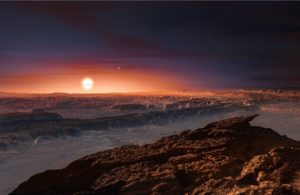
UPDATED: A small rocky planet has been discovered orbiting Proxima Centauri, the Sun’s closest stellar neighbour, and it may sustain an atmosphere and liquid water that could support life.
The discovery of the planet, which is named Proxima b, has a mass about 1.3 times that of the Earth and is just over four light years away, is detailed in a paper published today in the leading scientific journal Nature.
The SMC gathered commentary on the discovery from experts. Feel free to use these comments in your reporting.
Dr Nicholas Rattenbury, Rutherford Discovery Fellow, Department of Physics, University of Auckland, comments:
“The discovery is of a signal consistent with a planet orbiting the nearest star to our Sun, Proxima Centauri. The planet — which is called, for now, Proxima b — orbits in the region around its host star at a distance which we think would allow liquid water to exist on its surface, given the amount of radiation received at the planet’s surface from its host star. The analysis of the signal suggests that the planet could have a mass as low as 1.3 times the mass of the Earth. These two findings are exciting, as we are interested in finding planets which could host liquid surface water, as we think this is a very important ingredient for a planet to harbour life.
“Apart from being at the right distance from its host star, to have the sort of conditions suitable for surface life such as that we find on Earth, we think that a planet must have an atmosphere and the nature of that atmosphere is vital. This, in turn, means that the planet mustn’t be too large or two small. Too large and it would most likely have a thick, dense atmosphere, like a Neptune or a Jupiter, and we find it harder to envisage life like that we find on our Earth on such gaseous planets.
“Similarly, the planet can’t be too small, or it won’t have enough mass to hold onto an atmosphere for long enough for life to emerge — Mars in our solar system is smaller than Earth and lost its atmosphere over time, making it impossible for liquid water to remain on the surface. The newly discovered planet, Proxima b, might have a mass in the right range so that it too would have just the right amount of atmosphere to keep the surface warm and under enough pressure to keep water liquid on its surface. However there hasn’t been any detection of an atmosphere on Proxima b or of what gases that atmosphere might consist.
“No doubt the Proxima Centuri planetary system will now be the subject of further investigation, using other techniques to confirm the existence of the planet. Ideally we’d like to see transit observations of the planet — to see if Proxima b passes between us and its host star Proxima Centauri. This would cause a dip in the amount of light we see coming from Proxima Centauri, and would give us the radius of the planet. More importantly, such transit observations would get rid of that pesky word “minimum” in front of the phrase in the paper that the planet has a “minimum mass of about 1.3 Earth masses”. As it stands, the planet could be even more massive than Jupiter — and correspondingly be a planet very different to Earth — we simply don’t know yet. Further observations will hopefully resolve this issue.
“For now, it is an exciting discovery, mainly because we have found evidence of a planet orbiting the star nearest to our own Sun. The discovery is consistent with results from the exoplanet community which suggests that the Galaxy has planets in abundance, so perhaps we shouldn’t be surprised that the star nearest to our Sun also hosts at least one planet. To say that I’m not surprised isn’t to say that I’m not excited. If we choose to design a space probe mission to explore other planetary systems, then the Proxima Centauri system no doubt will be top of the list of systems to investigate.”
Professor Richard Easther, cosmologist and head of the Physics Department, University of Auckland, comments:
“This is a fascinating discovery. It extends the range of planets we have seen in the universe, and marks the detection of a roughly Earth-sized planet in the ‘Goldilocks zone’ of another star — one that is close enough to its sun that it would not be frozen solid, but not so close that water would boil.
“The excitement about planets that can support water is that water is one of the key ingredients for ‘life as we know it’. That said, this planet is very different from the Earth; the host star Proxima Centauri is a red dwarf, and a much fainter star than the sun.
“As such, this planet’s orbit will be a much smaller circle than the Earth’s orbit round the sun, and its ‘year’ is just 11 days long. Not only that, Proxima Centauri occasionally emits bursts of x-rays which could make the environment around it inhospitable to life. But on the other hand, red dwarf stars are very common in the universe, so finding a planet round this one makes it likely that there are many, many others.
“Proxima Centauri is the closest star to the Sun, but so faint it is invisible to the naked eye. Despite this it is easy to find in the sky as it is part of a three star system — the other two are much brighter, and in a tight orbit around one another. We see them as the single star, Alpha Centauri, one of the bright ‘pointers’ next to the Southern Cross.”